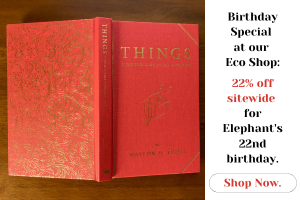Part three in a series on awareness practice. Click here for part one. Click here for part two.
As Trungpa Rinpoche said, “Ego is the starting point of the path.”
This means we have something to work with, something to tread on and to explore. Rinpoche also said that our perceptions of ego “arise from bewilderment—for we don’t exist.”
What there is, is a transparent intelligence that’s colored by the five aggregates, the components that make up this illusory, ungraspable mind and sense of self. Prajna or insight is this intelligence or penetrating insight that cuts through these five aggregates—and the Heart Sutra is the primary Buddhist text illuminating this.
Sutra usually refers to teachings of the Buddha, but in this case it is Avalokiteshvara, the bodhisattva of compassion, who expounds on prajna. The Buddha only confirms Avalokiteshvara’s explanation at the end.
This sutra is known as the Heart Sutra because it is a condensation, the essence or pith of several longer discourses. The sutra begins, “Thus have I heard…” because Buddha’s teachings were not written down until well after his death. This was a time when memory was a highly developed and valued skill and those with the best oral memories would recite the words of the Buddha at gatherings.
The Sutra was expounded on Vulture Peak Mountain 2550 years ago. The Buddha enters Samadhi or deep meditation there and lets Avalokiteshavara answer Shariputra’s question: “How should one practice the profound prajnaparamita?”
Paramita literally means the other shore. Shariputra is asking how to use prajna or insight, how to practice it to cut through illusions to the ultimate nature of reality. Avalokiteshvara answers that we should see “the five skandhas” (aggregates of form, feeling, perception, concepts and consciousness) to be empty of nature. Form is emptiness; emptiness is form.”
These words point to how to practice; no blind belief is required.
As we have seen in part one and part two of Awareness Practice, perceptions arise in the mind unobstructedly because there is nothing substantial. Forms or appearances are not separate from the empty-cognizance of mind. Furthermore, with prajna we see that form is empty of our preconceptions, judgments, and interpretations. But once the judgments and interpretations are gone, we still have to let go of the subtle label of “emptiness.”
“Form is emptiness” shines a light on the truth of our nonexistence and egolessness. But “emptiness is also form.”
In other words, mind is like a crystal ball that reflects all the forms and colors, all the appearances put before it. But it is not stained by any of them. It remains crystal clear—as does the true nature of mind. “Emptiness is also form” shines a light on the truth of our cognitive ability and clarity. Just as space is not sterile but full of possibilities, the mind is bright, not at all blank. And appearances arise. Then we see the indivisibility of emptiness and form. The empty aspect and this cognitive or clear aspect are inseparable, just as the warmth and burning capacity of fire are inseparable.
Today we trust the words of the Heart Sutra because for centuries those who have put the words into practice have discovered that they work.
Masters of meditation say that what we conventionally think of as a self is just a name given to empty presence and transparent intelligence which has no substance. Form, feeling, perception, formation, and consciousness (the five aggregates or skandhas) seem to create a continuous presence but are actually just a series of discontinuous mental events.
Awareness practice reveals just how temporary these components are. The idea of an “I” is just another discontinuous if persistent thought.
Tsoknyi Rinpoche speaks of the usefulness of the “mere I.” It is functional. We use it in speech. It is the belief in “solid I,” “social I” and “precious I” that is problematic.
The challenge is to learn to rest in openness. Meditation is not merely a stress reduction program. That is a watered down version of meditation, although it may be quite helpful.
Meditation is about letting go rather than self-enhancement or “self-improvement.” It’s ultimately about dissolving the illusory separation between self and other so that post meditation compassion arises effortless and spontaneously.
It is “solid I” that’s associated with discursive thoughts, conflicting emotions, and the struggle which makes life anxious.
Avalokiteshvara continues: “There is no birth and no cessation. There is no impurity and no purity. There is no decrease and no increase.”
Avalokiteshvara is pointing out that there is no real duality. Conceptual mind makes comparisons but comparisons do not exist by themselves in objective reality. They are labels projected onto appearances. They are only relatively real. The concept of purity depends on the concept of impurity, just as decrease depends on the concept of increase, good on bad, great and small, tall and short, etc. These are mere judgments in conceptual mind and have no inherent or absolute reality.
The Sutra next declares as empty the key concepts of the Hinayana, Buddha’s initial and provisional teachings on the skandhas, 12 nidanas, karma and the Four Noble Truths!
Because everything is dependent, there are no independent entities. Dependent origination demonstrates that temporary appearances rely upon many conditions. Karma starts with a flicker of ignorance—ignoring mind’s basic and spacious nature. But by recognizing mind’s basic nature in practice, we can wake up. In that moment of recognition there is no karma. Nothing happens in the empty mind stream. As Trungpa Rinpoche often said, “Discursive mind is short circuited.”
So the practitioner’s work is to stabilize this recognition, this open mind.
It is only from the unenlightened point of view that we seem to be caught in a seemingly continuous cycle of karma. But as long as we are caught, we must be very mindful of our conduct and respect karmic cause and effect.
Avalokiteshvara concludes the Heart Sutra with, “no suffering, no origin of suffering, no cessation of suffering, no path, no wisdom, no attainment and no non-attainment.”
Even the Four Noble Truths here bite the dust. They are empty. Suffering is due to positing a “self” separate from the rest of “reality.” But for bodhisattvas who realize emptiness through applying prajna in practice, there is no obscuration and no fear because there is no self to lose or be obscured.
Avalokiteshvara then praises the mantra of prajnaparamita:
Om Gate Gate Paragate Parasamgate Bodhi Svaha
According to Trungpa Rinpoche, the first Gate means that the conflicting emotions are gone; the second Gate means “primitive beliefs about reality “like eternalism or nihilism are gone. Paragate means “gone beyond” and Parasamgate means “completely gone beyond.” Bodhi means “completely awake…completely open” and Svaha means “so be it.”
Thus prajna realizes emptiness, which is beyond conventional versions of reality. Prajna frees us from self-centered suffering so that we can be of spontaneous benefit in the world.
Thus Buddha says, “Good, good, O son of noble family, thus it is.”
~
Editor: Jennifer Townsend







Read 3 comments and reply